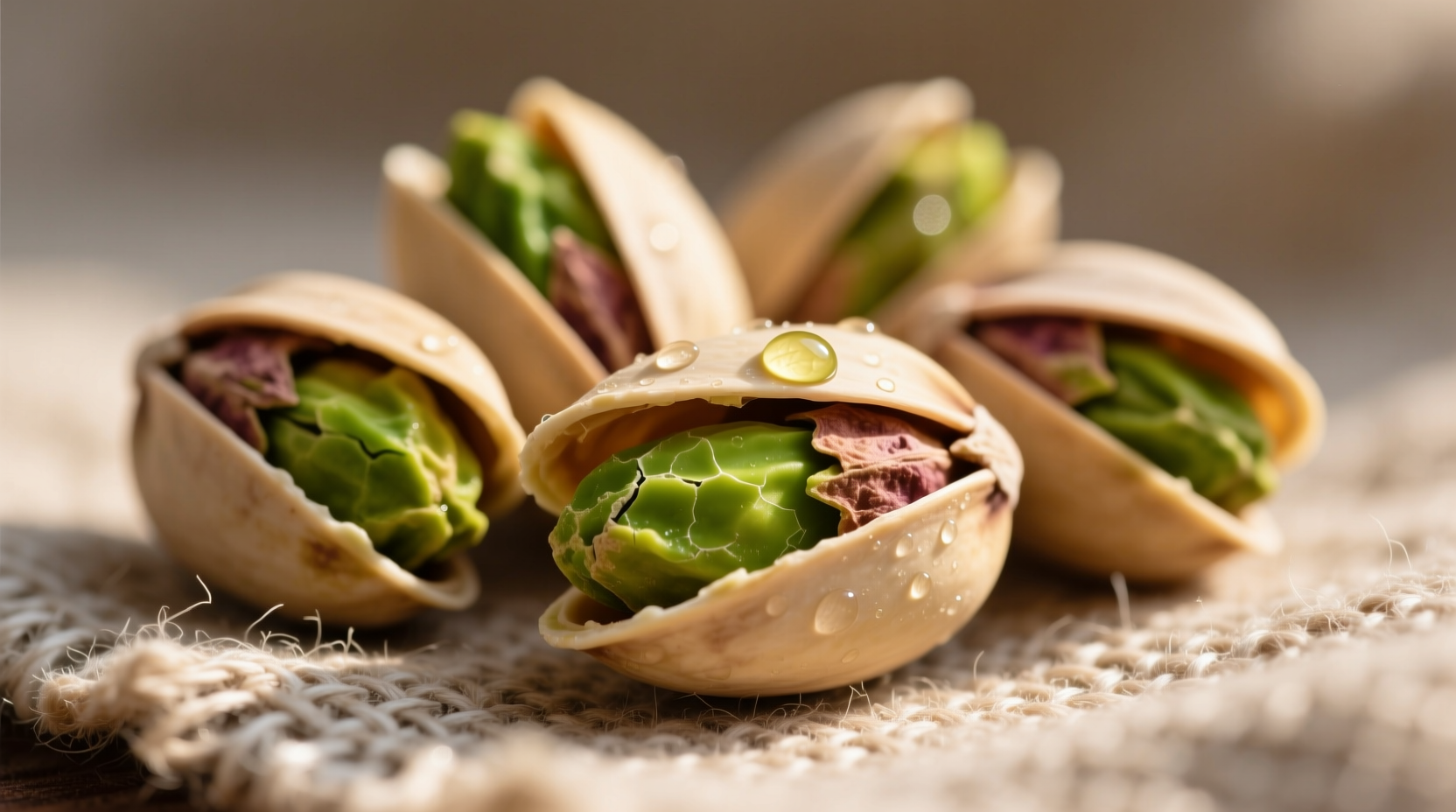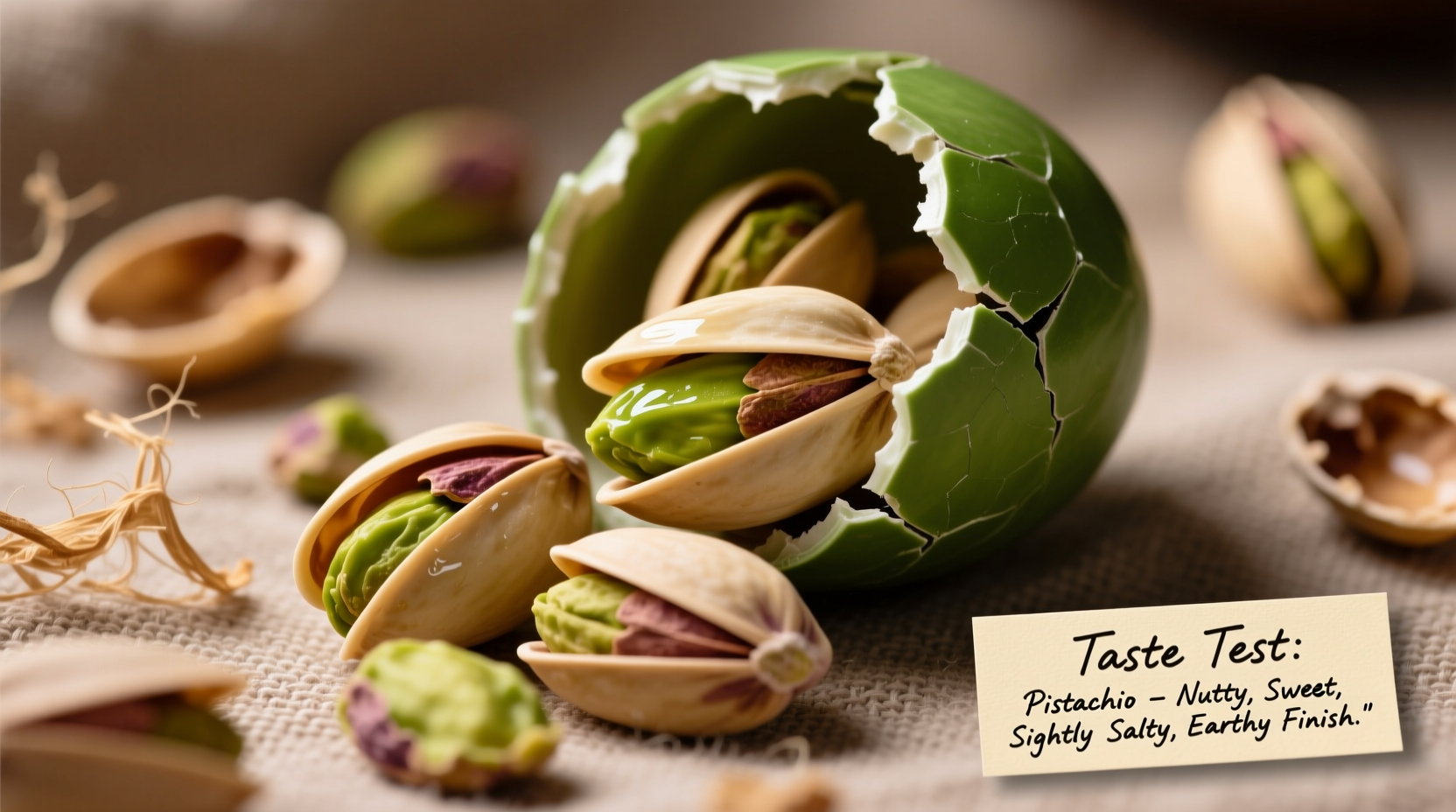Your First Encounter with Pistachios: What to Expect
When you crack open a pistachio shell and take your first bite, you'll immediately notice a pleasant nuttiness that's more complex than many other tree nuts. Unlike the straightforward richness of walnuts or the simple sweetness of cashews, pistachios offer a nuanced flavor experience that unfolds in stages.
The initial taste is mildly sweet with buttery notes, followed by subtle earthy undertones that give pistachios their distinctive character. The texture plays a crucial role in the overall experience - firm yet yielding with a satisfying crunch that releases more flavor as you chew. This combination of taste and texture creates what food scientists call "flavor persistence" - the taste lingers pleasantly on your palate rather than disappearing quickly.

Breaking Down the Pistachio Flavor Profile
Let's examine the specific elements that contribute to pistachios' unique taste:
Taste Dimensions
- Nutty foundation: A rich, toasted nut flavor that forms the base note
- Subtle sweetness: Natural sugars that balance the earthiness
- Buttery richness: Fat content (about 13g per ounce) creates a smooth mouthfeel
- Earthy undertones: Distinctive earthy notes that differentiate pistachios from other nuts
- Hint of saltiness: Present even in unsalted varieties due to mineral content
Chemical Composition Behind the Flavor
According to agricultural research from the University of California, pistachios contain specific flavor compounds that create their signature taste. The compound 2-ethyl-3-methylpyrazine contributes significantly to the nutty aroma, while hexanal provides grassy notes. The distinctive green color comes from chlorophyll, which also influences the flavor profile by adding subtle vegetal notes that complement the nuttiness.
| Nut Variety | Primary Flavor Notes | Texture Profile | Best Culinary Uses |
|---|---|---|---|
| Pistachios | Nutty, slightly sweet, earthy with buttery finish | Firm yet yielding with moderate crunch | Desserts, pesto, salads, Middle Eastern dishes |
| Almonds | Mild, subtly sweet, neutral | Hard crunch, less yielding | General baking, almond milk, snacks |
| Walnuts | Rich, robust, slightly bitter | Brittle crunch, oilier mouthfeel | Baking, salads, pesto variations |
| Cashews | Buttery, sweet, mild | Soft crunch, creamy when processed | Cream sauces, vegan cheese, stir-fries |
How Preparation Methods Transform Pistachio Flavor
The way pistachios are processed dramatically affects their taste profile. Understanding these differences helps you select the right type for your culinary needs:
Raw vs. Roasted Pistachios
Raw pistachios have a more delicate, naturally sweet flavor with pronounced grassy notes. Roasting triggers the Maillard reaction, which develops deeper nutty flavors while reducing some of the raw green notes. Lightly roasted pistachios maintain more of their natural sweetness, while dark roasted varieties develop almost coffee-like bitter notes that pair well with chocolate.
Agricultural studies from the International Nut and Dried Fruit Council show that roasting at 130°C for 15 minutes optimally enhances flavor compounds while preserving nutritional value. This precise temperature control explains why artisanal roasted pistachios often taste superior to mass-produced varieties.
Salted vs. Unsalted Variations
Even unsalted pistachios contain natural potassium and magnesium that create a subtle saltiness. Salted pistachios amplify this quality, making the natural sweetness more pronounced through contrast. The salt also enhances the perception of umami, creating a more complex flavor experience. For cooking applications, unsalted pistachios provide more control over final dish seasoning.
Geographical Influences on Pistachio Flavor
Pistachios grown in different regions develop distinctive flavor profiles based on soil composition and climate:
- Iranian pistachios: Known for their stronger, more intense flavor with pronounced earthy notes
- California pistachios: Typically milder with more pronounced sweetness
- Syrian pistachios: Often described as having the perfect balance between earthiness and sweetness
These regional differences follow a clear pattern documented by the USDA Agricultural Research Service - pistachios grown in hotter, drier climates tend to develop more concentrated flavors as the trees allocate resources to seed development.
How Freshness Affects Pistachio Taste
Freshness dramatically impacts pistachio flavor. Properly stored pistachios maintain their optimal taste for 6-12 months, but several indicators reveal when they've passed their prime:
- Visual cues: Fresh pistachios have vibrant green kernels; fading to yellow indicates oxidation
- Texture test: Fresh kernels snap cleanly when bent; stale ones bend without breaking
- Smell test: Rancid pistachios develop a paint-like odor from oxidized fats
- Taste test: Stale pistachios taste cardboard-like with diminished sweetness
Proper storage in airtight containers in cool, dark places preserves flavor compounds. For long-term storage, freezing pistachios maintains freshness for up to two years without significant flavor degradation.
Culinary Pairings That Enhance Pistachio Flavor
Understanding pistachios' flavor profile helps create perfect pairings:
Sweet Combinations
- Dark chocolate: The bitterness complements pistachios' earthiness
- Honey and rosewater: Traditional Middle Eastern combination that enhances natural sweetness
- Berries: The tartness balances pistachios' richness
Savory Pairings
- Lemon zest: Bright acidity cuts through the fat content
- Feta cheese: Salty tang contrasts beautifully with nuttiness
- Garlic and herbs: Creates complex pesto variations
Professional chefs often use pistachios in finishing dishes rather than cooking them extensively, as high heat can diminish their delicate flavor profile. The optimal approach is to add them in the final stages of preparation to preserve their distinctive taste.
How to Select the Best-Tasting Pistachios
Follow these practical guidelines when shopping for pistachios:
- Choose shells that are partially open ("smiling") - fully closed shells often contain immature kernels
- Look for vibrant green kernels rather than yellowish ones
- Sniff test: Fresh pistachios should smell clean and nutty, not musty or stale
- Check for uniform size, which indicates consistent growing conditions and flavor
- When buying in-shell, shake them - rattling indicates dried-out kernels
For the most authentic pistachio experience, seek out varieties labeled "Kerman" (California) or "Ahmad Aghaei" (Iranian), which are known for their superior flavor profiles according to sensory evaluations conducted by the University of California's Department of Food Science.
Understanding Pistachio Flavor in Cultural Context
Pistachios have been prized for their distinctive flavor for thousands of years. Historical records from ancient Persia describe them as "the smiling nut" because of their naturally split shells. This cultural appreciation continues today, with traditional preparation methods designed specifically to enhance their unique taste profile.
In Middle Eastern cuisine, pistachios are often lightly toasted with cardamom to bring out their natural sweetness while adding complementary aromatic notes. Italian gelaterias use them to create distinctive pistachio gelato that showcases the nut's complex flavor without overwhelming it with sugar.
Practical Tips for Maximizing Pistachio Flavor
Here are actionable techniques to get the most flavor from your pistachios:
- Light toasting: 5-7 minutes at 325°F (163°C) enhances nuttiness without burning
- Chopping technique: Rough chop rather than fine mince preserves flavor compounds
- Moisture control: Pat dry before use in recipes to prevent flavor dilution
- Flavor layering: Combine with complementary ingredients rather than masking the primary flavor
When incorporating pistachios into recipes, remember that their flavor is more delicate than many other nuts. Using them as a finishing element rather than cooking them extensively preserves their distinctive taste profile.











 浙公网安备
33010002000092号
浙公网安备
33010002000092号 浙B2-20120091-4
浙B2-20120091-4